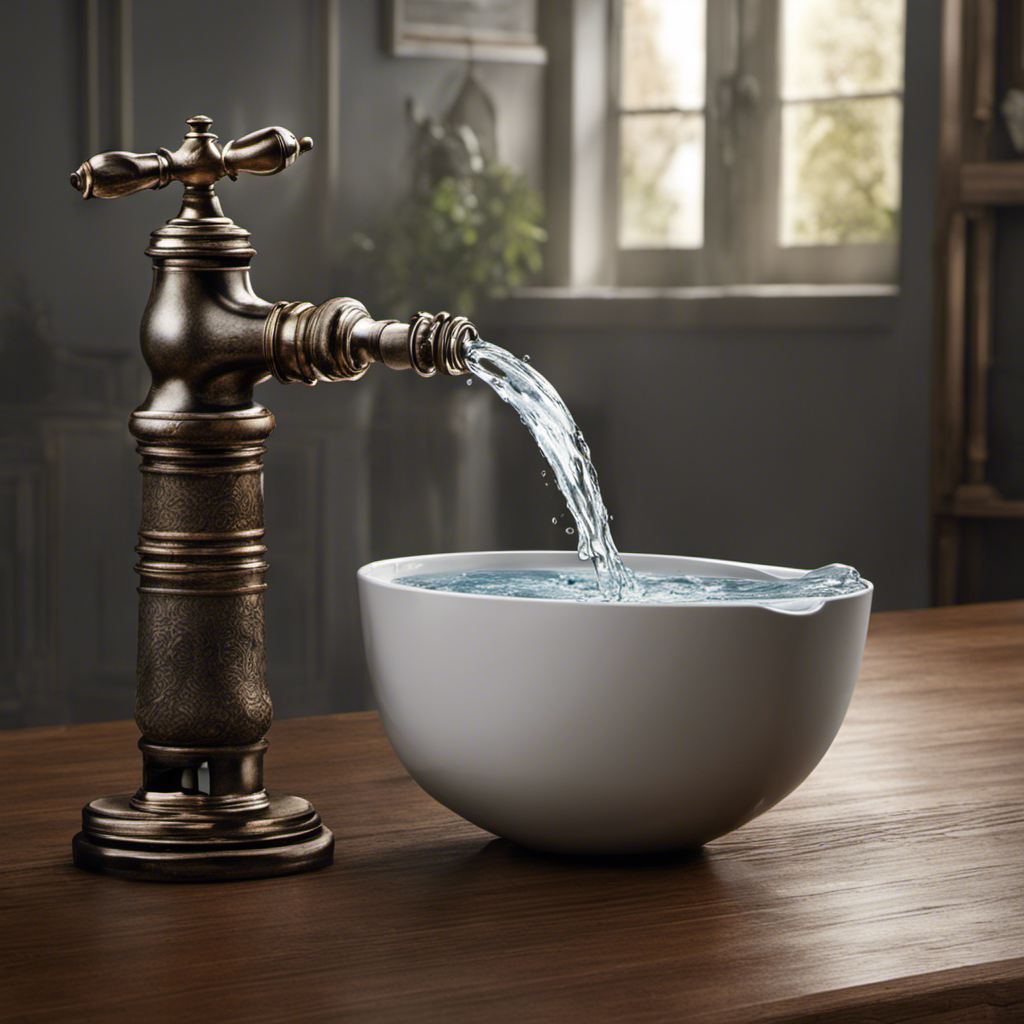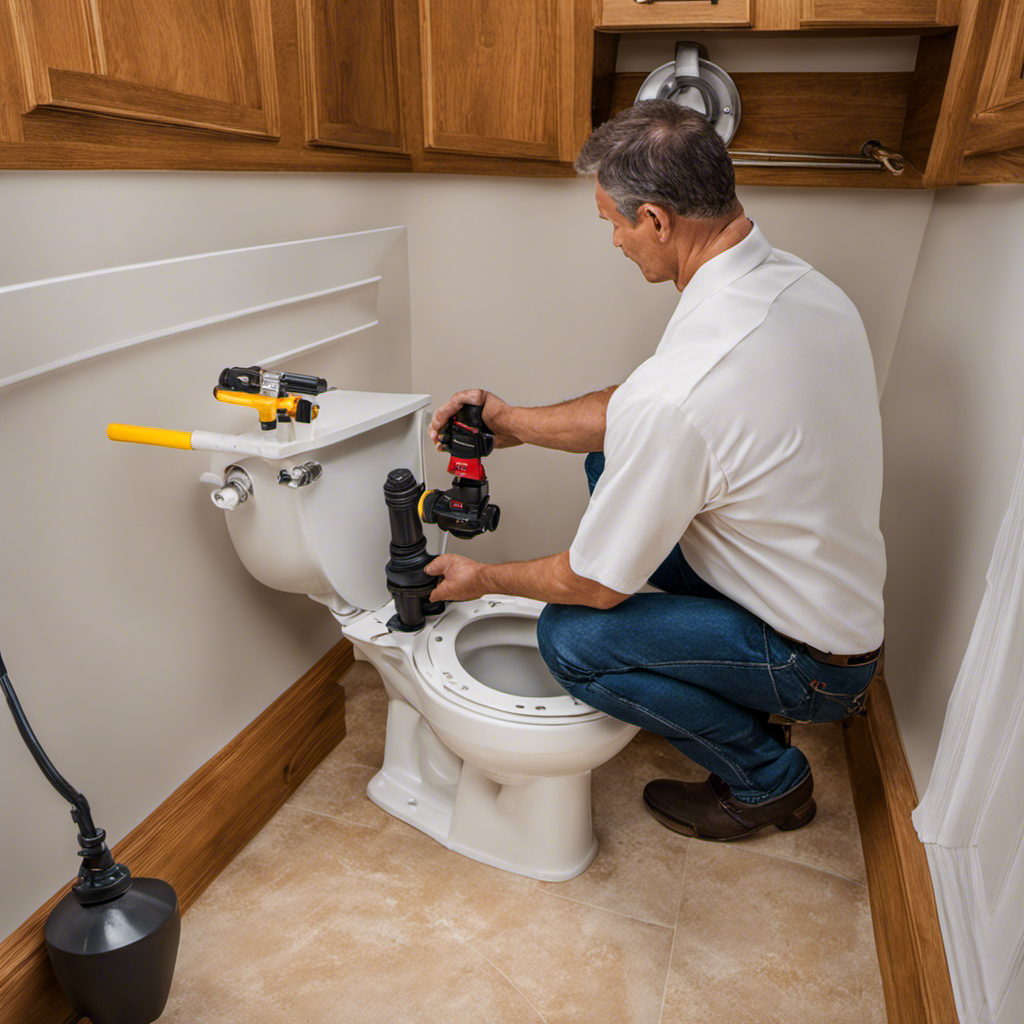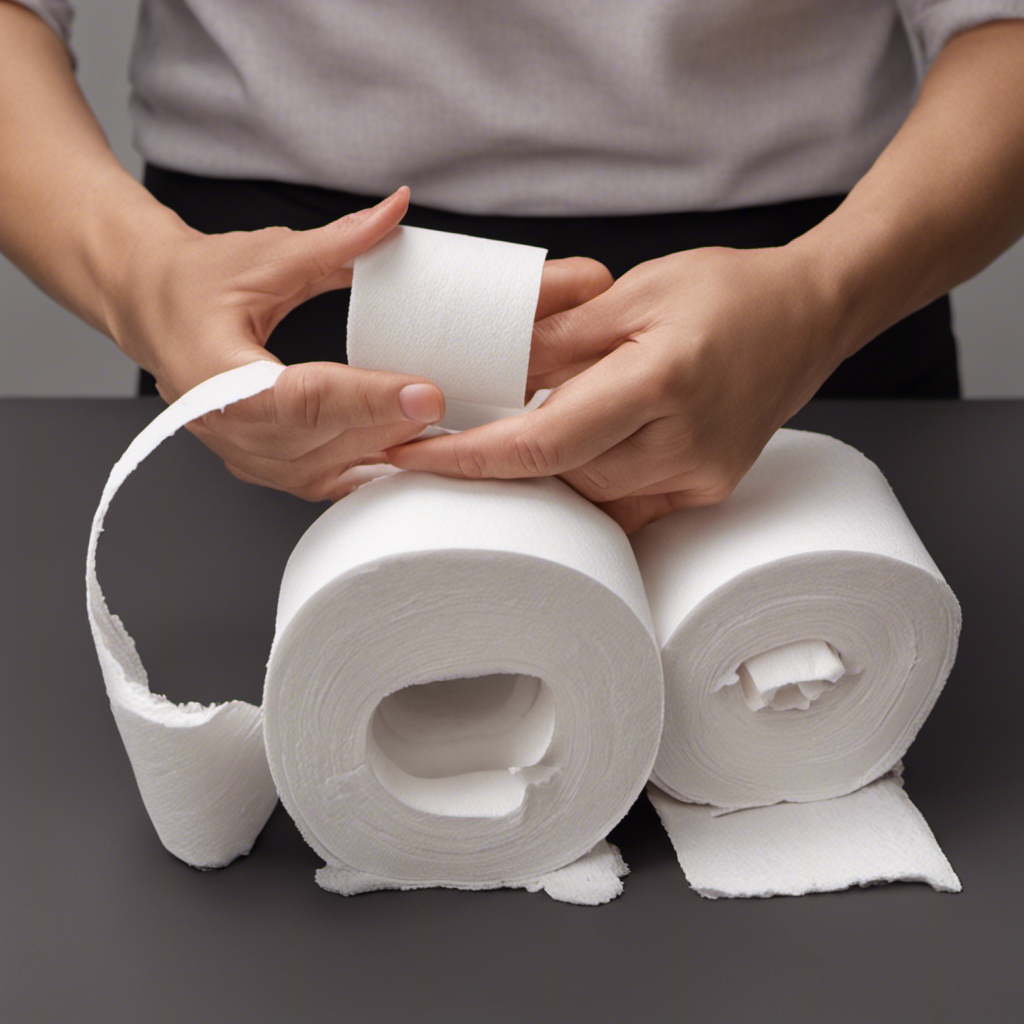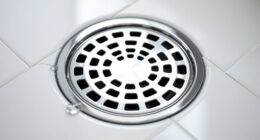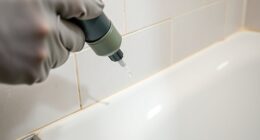Do you cringe every time you see those unsightly brown stains in your toilet bowl? Don’t worry, you’re not alone. Brown limescale buildup can be a pesky problem, but with the right approach, you can easily get rid of it.
In this step-by-step guide, we’ll show you how to tackle the issue head-on. From understanding the causes to preventing future buildup, we’ve got you covered.
Get ready to say goodbye to brown limescale and hello to a sparkling clean toilet.
Key Takeaways
- Hard water with high mineral levels contributes to the formation of brown limescale.
- Iron in the water can cause limescale to turn brown.
- Different cleaning methods like chemical cleaners, mechanical methods, and combination methods can be used to remove brown limescale.
- To prevent future limescale buildup, regularly clean the toilet, flush thoroughly after each use, and consider using a toilet bowl cleaner designed to prevent limescale.
Understanding the Causes of Brown Limescale
To understand why brown limescale forms in your toilet, you need to know the main causes. One of the primary factors contributing to brown limescale formation is hard water. When water contains high levels of minerals such as calcium and magnesium, it becomes hard. These minerals can accumulate over time and form limescale deposits in your toilet.
Additionally, the presence of iron in the water can cause the limescale to turn brown. Understanding limescale removal techniques is crucial to effectively tackle this issue. There are various methods you can try, such as using vinegar, lemon juice, or commercial limescale removers. Scrubbing the affected areas with a brush or employing a pumice stone can also help remove the brown limescale.
Assessing the Severity of the Limescale Buildup
When assessing the severity of limescale buildup, there are three key points to consider.
First, visible limescale indicators can help determine the extent of the problem. Look for white, chalky deposits on surfaces, faucets, and appliances as signs of limescale buildup.
Second, measuring limescale thickness can provide a more accurate assessment. Use a ruler or caliper to measure the thickness of the limescale layer, as this will help determine the level of cleaning required.
Lastly, assessing cleaning methods is crucial to effectively removing limescale. Consider different techniques such as descaling solutions, vinegar, or scrubbing to find the most suitable method for your specific limescale problem.
Visible Limescale Indicators
You can easily spot visible limescale indicators in your toilet by looking for brown stains and buildup along the waterline and in the bowl. These indicators are common limescale problems that can be unsightly and difficult to remove.
To effectively tackle these limescale stains, here are some steps you can follow:
-
Gather the necessary tools and materials:
- Toilet brush
- Rubber gloves
- White vinegar or a commercial limescale remover
- Scrubbing sponge or cloth
-
Put on the rubber gloves to protect your hands from the cleaning agents.
-
Pour white vinegar or a limescale remover into the toilet bowl, ensuring that it covers the stained areas.
-
Let the cleaning agent sit for a few minutes to loosen the limescale buildup.
-
Scrub the stained areas using a toilet brush or a scrubbing sponge.
-
Flush the toilet to rinse away the loosened limescale and cleaning solution.
Measuring Limescale Thickness
Measuring the thickness of limescale can be done using a simple method. By detecting early signs of limescale buildup, you can prevent further damage and keep your toilet clean and functional.
To measure the density of limescale, follow these steps:
- Fill a glass with vinegar or a limescale remover solution.
- Submerge a clean, dry ruler into the liquid until it touches the bottom.
- Slowly lift the ruler out of the liquid, allowing any limescale to stick to it.
- Measure the thickness of the limescale on the ruler in millimeters.
Assessing Cleaning Methods
Assessing the effectiveness of different cleaning methods can help determine the best solution for removing limescale from your toilet. When evaluating effectiveness, it’s important to compare alternatives to find the most efficient and reliable method. Here are three sub-lists to consider:
-
Chemical cleaners:
-
Bleach: Effective at removing limescale, but may require scrubbing.
-
Descalers: Specially formulated to dissolve limescale without scrubbing.
-
Vinegar: Natural alternative that can be effective, but may require longer soaking time.
-
Mechanical methods:
-
Scrubbing with a toilet brush: Requires manual effort, but can be effective.
-
Pumice stone: Gently rubs away limescale, but be careful not to scratch the surface.
-
Power scrubbers: Electric tools that can quickly remove limescale with minimal effort.
-
Combination methods:
-
Using a chemical cleaner followed by scrubbing for tougher stains.
-
Soaking with vinegar and then using a pumice stone for gentler cleaning.
-
Using a power scrubber with a descaler for a fast and efficient clean.
By evaluating the effectiveness of these different cleaning methods, you can determine the best approach for removing limescale from your toilet.
Now, let’s move on to preparing your cleaning solution.
Preparing Your Cleaning Solution
When it comes to preparing your cleaning solution, there are three key points to consider: effective cleaning ingredients, proper dilution ratios, and safety precautions.
First, choose cleaning ingredients that are known for their effectiveness in breaking down dirt and grime. Look for ingredients such as hydrogen peroxide, vinegar, or baking soda.
Next, make sure to follow the proper dilution ratios to ensure that the cleaning solution is effective without causing any damage.
Effective Cleaning Ingredients
To effectively clean brown limescale in your toilet, try using a mixture of vinegar and baking soda. This natural cleaning alternative is not only effective but also environmentally friendly. Here’s how you can use these ingredients to tackle the stubborn limescale:
-
Start by pouring a cup of vinegar into the toilet bowl. Vinegar is known for its acidic properties, which help dissolve the limescale buildup.
-
Let the vinegar sit for a few minutes to allow it to penetrate the limescale.
-
Next, sprinkle baking soda over the vinegar. Baking soda is a mild abrasive that will help scrub away the limescale without damaging the toilet surface.
-
Grab a toilet brush and scrub the mixture around the toilet bowl, paying extra attention to the areas with heavy limescale buildup.
-
Leave the mixture to sit for at least 15 minutes to allow the vinegar and baking soda to work their magic.
-
Finally, flush the toilet and admire the sparkling clean result.
Proper Dilution Ratios
Now that you know about the effective cleaning ingredients, it’s important to understand the proper dilution ratios to ensure dilution accuracy and solution effectiveness. Improper dilution can lead to ineffective cleaning or even damage to the toilet surface.
Follow these steps to achieve the correct dilution ratios:
- Read the instructions on the cleaning product carefully. It will usually provide the recommended dilution ratio.
- Measure the cleaning product and water accurately using measuring cups or a measuring scale.
- Mix the cleaning product and water in a separate container, following the recommended ratio.
- Stir the solution well to ensure proper mixing.
- Test the solution on a small, inconspicuous area of the toilet to check for any adverse reactions or damage.
- If the test is successful, apply the solution to the brown limescale in the toilet according to the instructions.
Safety Precautions to Consider
It’s important to take safety precautions into account when handling cleaning products. Cleaning products can contain chemical hazards that can be harmful if not used properly. To ensure your safety, follow these steps:
-
Wear protective equipment:
-
Gloves: Choose gloves made of materials that are resistant to the chemicals you are using.
-
Goggles: Protect your eyes from splashes or fumes by wearing goggles.
-
Apron: Use an apron to protect your clothes from any spills or splashes.
-
Read the product labels:
-
Familiarize yourself with the warnings and instructions provided on the labels.
-
Follow the recommended dilution ratios to avoid using excessive amounts.
-
Ventilate the area:
-
Open windows or use fans to ensure proper airflow and minimize exposure to fumes.
Applying the Cleaning Solution to the Toilet Bowl
After scrubbing the toilet bowl with the cleaning solution, apply it to the brown limescale to effectively remove it.
To begin, make sure you have the necessary cleaning tools, such as a toilet brush and rubber gloves. Put on the gloves to protect your hands from any harsh chemicals in the cleaning solution.
Then, dip the toilet brush into the cleaning solution and scrub the entire inside of the toilet bowl, paying extra attention to the areas with brown limescale. Apply firm pressure and use circular motions to effectively break down the limescale.
After scrubbing, let the cleaning solution sit for a few minutes to allow it to penetrate the limescale.
Scrubbing Away the Brown Limescale
To effectively remove the brown limescale, start by scrubbing the entire inside of the toilet bowl with the cleaning solution. This will help break down the limescale and make it easier to remove.
Here’s a step-by-step guide on how to scrub away the brown limescale:
- Put on protective gloves and goggles to protect yourself from the cleaning solution.
- Dip a toilet brush into the cleaning solution and apply it to the inside of the toilet bowl.
- Use the brush to scrub the bowl thoroughly, paying extra attention to areas with heavy limescale buildup.
- Scrub in circular motions, applying pressure to loosen the limescale.
- Rinse the brush frequently in clean water to remove any limescale residue.
- Continue scrubbing until the brown limescale is completely gone.
Flushing and Rinsing the Toilet Bowl
Now that you’ve scrubbed away the brown limescale from your toilet bowl, it’s time to flush and rinse to complete the cleaning process.
Flushing the toilet will help remove any loose debris and leftover cleaning solution. To do this, simply press the flush lever or button on your toilet. Allow the water to fully drain and refill the bowl. This will help to eliminate any remaining limescale particles and leave your toilet bowl looking fresh and clean.
After flushing, it’s important to give the toilet bowl a final rinse. Use a clean toilet brush or a jug of water to pour water around the inside of the bowl, ensuring that all surfaces are thoroughly rinsed. This step will help remove any residue or cleaning solution that may be left behind.
Transitioning into the next section about preventing future brown limescale buildup, it’s essential to understand that regular toilet bowl maintenance is key to keeping limescale at bay.
Preventing Future Brown Limescale Buildup
Remember, regular maintenance and using a descaling agent can help prevent the formation of brown limescale in your bathroom. To ensure your toilet remains in pristine condition, follow these steps:
-
Clean the toilet regularly:
- Use a toilet brush to scrub the bowl and remove any residue.
- Flush the toilet thoroughly to rinse away any remaining dirt.
-
Use a descaling agent:
- Apply a descaling agent to the inside of the toilet bowl.
- Allow the agent to sit for the recommended amount of time.
- Scrub the bowl again to remove any loosened limescale.
-
Maintain toilet hygiene:
- Flush the toilet after each use to prevent buildup.
- Avoid using abrasive cleaners that can damage the toilet surface.
- Consider using a toilet bowl cleaner specifically designed to prevent limescale buildup.
Conclusion
In conclusion, now that you’ve followed the step-by-step guide on how to get rid of brown limescale in your toilet, you can bid farewell to the unsightly stains and enjoy a clean and fresh bathroom.
By understanding the causes and severity of limescale buildup, preparing and applying the cleaning solution, and scrubbing away the stubborn stains, you’ve successfully tackled this issue.
Remember, prevention is key to avoid future brown limescale buildup. So, keep up with regular cleaning and maintenance to keep your toilet sparkling like new.
Happy cleaning!

